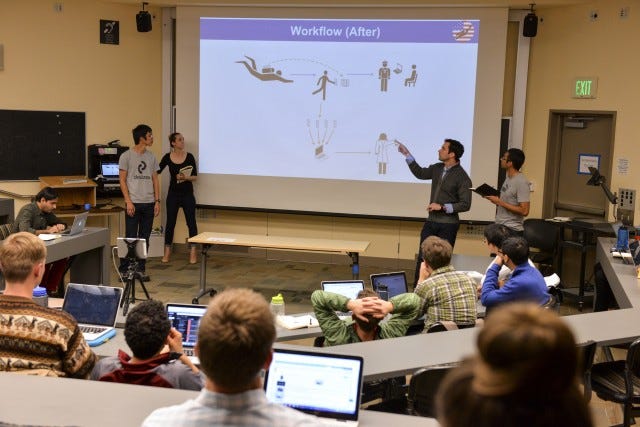Stanford’s Spring Hacking for Defense (H4D) Course is Getting Ready to Tackle Government’s Toughest Problems
Eight Teams Solve Problems For the U.S. State Department, FBI, Space Force and More
Hacking for Defense is a graduate-level course focused on defense tech entrepreneurship taught at more than 70 colleges and universities across three continents. More than 2,000 students have successfully completed the intensive project-based program.
The 2024 Spring quarter at Stanford University starts April 1st and the graduate Hacking for Defense (H4D) course at Stanford kicks off on April 2nd. H4D is already getting ready with student teams preparing to hit the ground running on solving national security problems. Hacking for Defense is a graduate level university course sponsored by the Office of Naval Research that teaches students to work with the government national security organizations to rapidly address the nation’s emerging threats and security challenges. This unique course stands at the crossroads of academia and real-world governmental needs, offering students an unparalleled opportunity to apply their skills to solve pressing national security challenges.
This spring’s Stanford H4D course features eight teams tackling eight national security problems sponsored by various defense and civilian agencies, demonstrating the multifaceted nature of the challenges the United States faces in maintaining national security, fostering innovation, and promoting sustainable growth, both domestically and internationally. The teams have 10 weeks to learn about their problem, use the H4D methodology of the Lean Launchpad to solve the problem, and begin developing solutions. Many go on after the class to start their own start-ups serving the government.
Here is a look at the 8 problem the Stanford teams will be tackling this spring:
Dynamic Space Operations
Sponsored by the Space Force and the Defense Innovation Unit, students will tackle a challenge for the Assured Access to Space Office at Space Systems Command (SSC/AATS), which needs the ability to safely grapple and dock between spacecraft (without inducing a tumble, damaging, or creating debris) to reconstitute space vehicles and capabilities on-orbit by enabling spacecraft maintenance, refueling, upgrade, construction, and manufacturing.
Area Sentiment Assessment
Central Command and the J39 Information Operations Division at USCENTCOM have tasked students with developing the ability to assess social media natural language queries over long periods of time to assess public sentiment within the USCENTCOM area of operation so operational effectiveness can be measured.
Guyana's Green Growth
In collaboration with the State Department, students will work with food producers in Guyana who need sustainable measures to increase the production of high-value agricultural products to reduce food insecurity in the intra-Caribbean region.
Race to Conquer the Battlespace
Sponsored by the European Command (EUCOM), this challenge focuses on US EUCOM analysts who need a way to ingest, orchestrate, and visualize data from disparate autonomous systems capabilities used in land, sea, and air domains to better understand the battlespace to inform operational decisions.
Caribbean's Clean Climate
The State Department is tasking students to work with the Barbados Office of Energy, which needs a way to harness existing renewable energy and store it to reach their climate goals and strengthen their energy infrastructure.
Fostering AI for the FBI
The Federal Bureau of Investigation (FBI) and FBI Intelligence Analysts need streamlined processes that utilizes AI/LLMs to prevent crimes against children by identifying, locating, and disrupting individuals and groups producing and proliferating Child Sex Abuse Material (CSAM).
If You’re Not First, You’re Last
In partnership with In-Q-Tel, this challenge addresses the need to work with F1 Formula crews who need a standardized methodology to gather and communicate information reports via telemetry to efficiently operate their car when faced with issues by other competitors on the track.
House of Laws
The Office of the Secretary of Defense Commanders' and Agency Directors' Staff need a consolidated repository of all law and federal policy that they can query to provide data-driven recommendations to leaders making operational decisions.
Team Aqualink from a previous H4D Stanford class presenting their early hypothesis and findings to the class.
“We are excited about the set of problems the students will be tackling this spring,” noted Jeff Decker, PhD, H4D program director and instructor. “This is the ninth year running the H4D course at Stanford, where it originated, and we’ve had some really incredible concepts and companies that have launched out of the course and gone on to become successful companies producing commercial products and government capabilities. This spring has a lot of promise for breakthrough innovation.”
H4D offers students a unique opportunity to work closely with government agencies, applying their academic knowledge to real-world problems. The diversity of the challenges reflects the course's commitment to addressing a broad spectrum of issues, from national security to environmental sustainability and technological innovation.
By fostering a direct connection between students and government agencies, the H4D course not only provides practical, hands-on learning experiences but also contributes to the development of innovative solutions that can have a significant impact on society and national security. This approach highlights the vital role of academic institutions in supporting national and global efforts to tackle complex challenges, paving the way for future collaborations between the government, academia, and the public sector.
As the spring quarter progresses, stay tuned to see the fascinating solutions the students develop for these critical challenges.
To learn more about the H4D course at Stanford University, visit h4d.stanford.edu; to learn more about H4D around the world, visit h4d.us. To read excerpts of the NEW upcoming H4D textbook, subscribe to the H4D Stanford Substack at stanfordh4d.substack.com.




